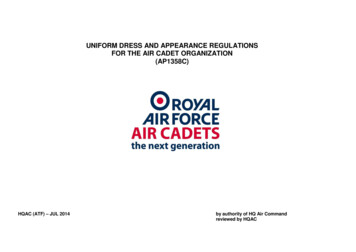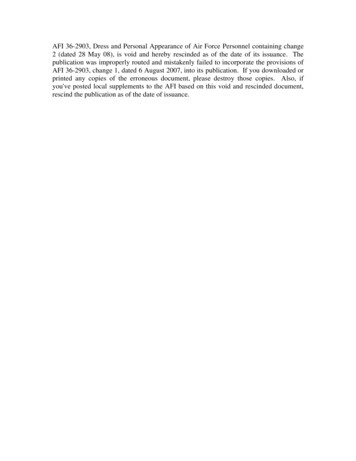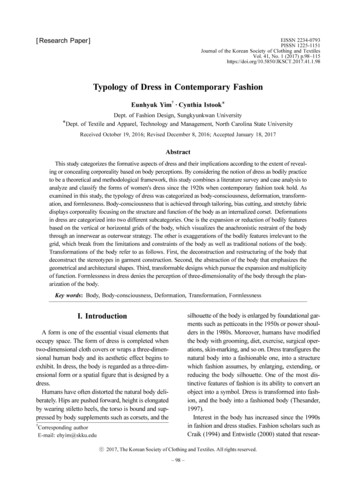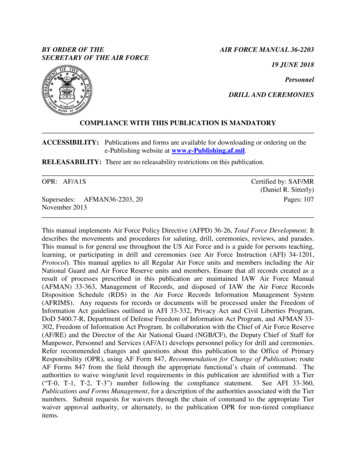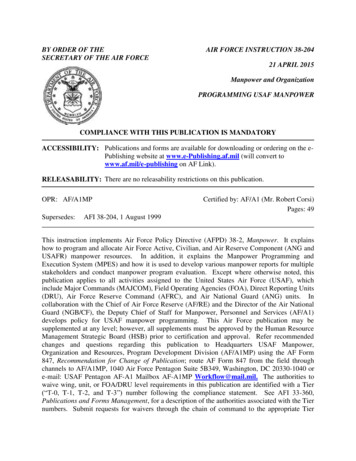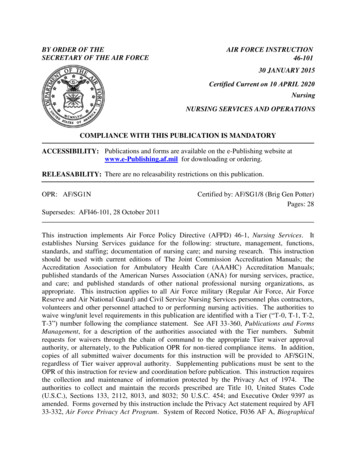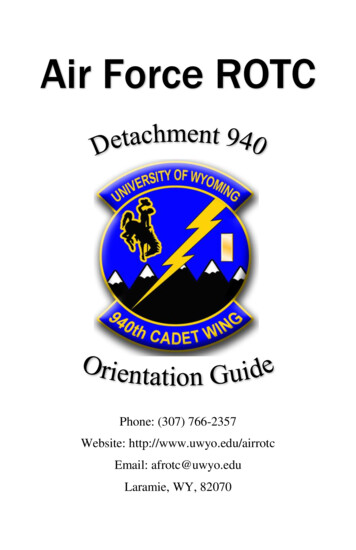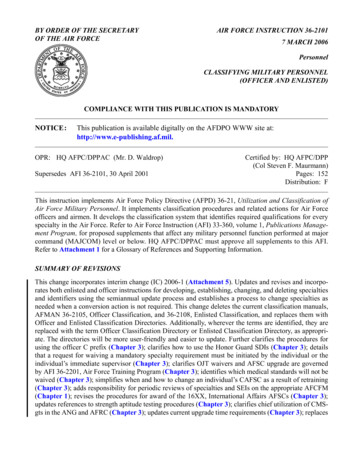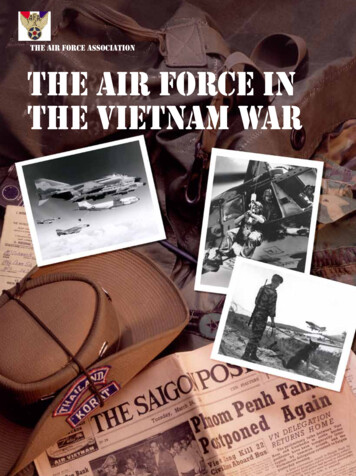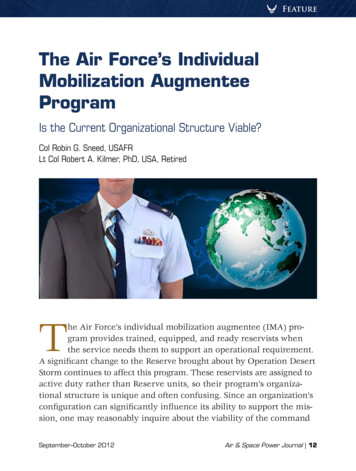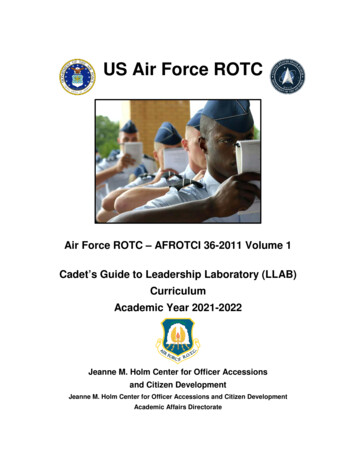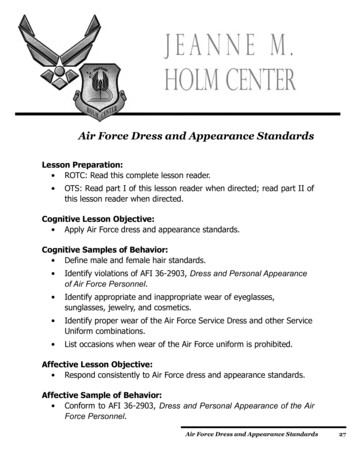
Transcription
Air Force Dress and Appearance StandardsLesson Preparation: ROTC: Read this complete lesson reader. OTS: Read part I of this lesson reader when directed; read part II ofthis lesson reader when directed.Cognitive Lesson Objective: Apply Air Force dress and appearance standards.Cognitive Samples of Behavior: Define male and female hair standards. Identify violations of AFI 36-2903, Dress and Personal Appearanceof Air Force Personnel. Identify appropriate and inappropriate wear of eyeglasses,sunglasses, jewelry, and cosmetics. Identify proper wear of the Air Force Service Dress and other ServiceUniform combinations. List occasions when wear of the Air Force uniform is prohibited.Affective Lesson Objective: Respond consistently to Air Force dress and appearance standards.Affective Sample of Behavior: Conform to AFI 36-2903, Dress and Personal Appearance of the AirForce Personnel.Air Force Dress and Appearance Standards 27
PART IAs an officer, you must display the qualities of a leader and apply the techniques ofleadership. You’ll set the example, so make it a good one! The manner in whichyou follow dress and grooming standards reflects pride in yourself, your profession,your unit, and the Air Force. You should always strive to exceed the minimum standards inall you do, especially in dress and grooming—lead by example!The Air Force dress and grooming standards are a mixture of tradition and practicality.The uniform draws attention to the individual. The image you present will leave a lastingimpression about you and the entire Air Force on everyone you meet. Any large businessor organization that wants to be recognized as professional sets certain standards ofdress and grooming for its personnel. The Air Force is no different. The American publicdraws certain conclusions about military effectiveness based on the image that Air Forcemembers present. It’s been said that a military officer can be picked out of a crowd justby the image he or she presents. Certainly, one’s weight control, military bearing, andconfidence are part of this image. The image of a disciplined service member who can berelied on to do the job excludes the extreme, the unusual, and the faddish.Personal cleanliness, disciplined behavior, and pride in the uniform will directly affect moralein the everyday work environment. It’s up to us to maintain ourselves as the professionalswe are. More importantly, however, each of us represents the Air Force and the UnitedStates in general. Discredit on one brings discredit on all.Uniforms must be clean, neat, and correct in design and specifications, fitted properly,pressed, and in good condition (i.e., not frayed, worn out, faded, torn, patched, etc.). Allclosures are to be kept zipped, snapped, or buttoned. Shoes requiring shining must beshined and in good repair. All service uniforms are authorized for year-round wear, unlessthe installation commander prescribes otherwise. As we explain the various uniformcombinations, we’ll concentrate on the officer’s uniform. For information on proper wearof uniforms by enlisted Airmen, consult AFI 36-2903, Dress and Personal Appearance ofthe Air Force Personnel.BASIC PHILOSOPHY AND ENFORCEABILITYThe Air Force philosophy is that the uniform will be plain, distinctive, and standardized.This standardization includes a minimum number of authorized badges, insignia,and devices.Individual pride in one’s personal appearance and in wearing the uniform greatly enhancesthe esprit de corps essential to an effective military force. Therefore, it’s most importantfor all members to maintain a high standard of dress and personal appearance. The fourelements of this standard are neatness, cleanliness, safety, and military image. The first28
three are absolute, objective criteria needed for the efficiency and well-being of the AirForce. The fourth military image is subjective, but necessary.Appearance in-uniform is an important part of military image. Judgment on what is the properimage differs in and out of the military. The American public and its elected representativesdraw certain conclusions about our military effectiveness based on the image that AirForce members present. The image must instill public confidence and leave no doubt thatservice members live by a common standard and respond to military order and discipline.Each member has the responsibility to maintain an “acceptable military image” as well asthe right, within limits, to express individuality through his or her appearance.Members will wear only the uniform items prescribed by AFI 36-2903, Dress and PersonalAppearance of the Air Force Personnel. Personnel who violate the specific prohibitionsand requirements of that regulation may be subject to appropriate administrative action orprosecuted under the Uniform Code of Military Justice (UCMJ).WEAR OF THE AIR FORCE UNIFORMExcept when authorized to wear civilian clothes according to AFI 36-2903, Dress andPersonal Appearance of the Air Force Personnel, Airmen will wear the appropriateAir Force uniform while performing their military duties.Personnel assigned to non-Air Force military installations will comply with the order ofdress that most nearly conforms to the order of dress for the particular host service, forexample, service uniform, combat uniform, and so forth. When the host service orderof dress is a combat uniform, Airmen will wear the Airman Battle Uniform (ABU). Whenauthorized, members may also wear distinctive berets.Airmen attending a special event, either social or official, must wear the service dressuniform unless the host or hostess requests civilian dress or the commander specifiesotherwise. Airmen wear the service dress uniform when the Air Force would benefit byhaving its representatives appear in that uniform. This rule applies to all social events not ofa purely personal nature. A member who receives a written invitation that doesn’t specifythe dress required should ask the social secretary or the secretary of the host organizationfor recommendations as to the expected dress. When several Air Force activities are inthe same locality, the senior commander will determine the proper dress uniforms forspecific seasons.Optional uniform items may be worn when a required item isn’t prescribed. Commanderswon’t direct the wear of optional items unless these items are provided at no cost to Airmen.Commanders won’t prohibit the wear of optional items.Members may alter uniform clothing to improve fit. However, these alterations must notchange the intended appearance or required function of the uniform as designed.Air Force Dress and Appearance Standards 29
Terms ExplainedAs used here, these terms mean the following: Right or Left. The wearer’s right or left. Installation Commander. The person who is responsible for and controls thepersonnel, facilities, equipment, and real estate constituting an Air Force base,station, operating location, etc. On-Duty. The hours a person is actually at work, as required by assignment. Mandatory Uniform. A complete uniform combination of selected items fromAirmen’s mandatory clothing. Mandatory Clothing Items. Uniform clothing items each Airman must alwayshave, according to AFI 36-2903, Dress and Personal Appearance of the Air ForcePersonnel. Optional Clothing Items. A uniform clothing item, other than a mandatory clothingitem, approved for wear by all Air Force personnel. Accoutrements. Medals, ribbons, insignia, badges, emblems, tags, scarves,gloves, etc., authorized for wear on or with any uniform. Service Uniforms. All authorized blue uniform combinations.Basic PolicyAs an Airman, you’re always in the public eye. The image you present reflects on us all.Therefore, it’s extremely important you make a positive impression at all times.Personal Hygiene. This is at an individual’s discretion. All Airmen should bathe and usetoiletries as necessary to prevent any offensive odors.Personal Grooming. Airmen must present a professional image at all times. Membersshould also appear neat and well groomed. Additionally, as stated before, avoid extremeand faddish styles.30
PERSONAL GROOMING STANDARDSHair StylesOverall, hair should be clean, well-groomed, and neat. Avoid using an excessiveamount of grooming aids (thus, it’s not permissible to grow your hair long and slickit back while in uniform). You may dye your hair if you wish, but it must look natural.Hair must not touch the eyebrows when groomed and may not protrude below the frontband of properly worn headgear for males. For females, hair may be visible when headgearis properly worn.Males. Men’s hairstyles must have a tapered appearance on both sides and back, bothwith and without headgear. A tapered appearance outlines the individual’s hair to conformto the shape of the head, curving inward to the termination point. The bulk or thickness ofhair must not exceed 11/4 inches, regardless of length. The bulk may not exceed 1/4 inch atthe termination point. The hair must not touch the ears and only the closely cut or shavedhair on the back of the neck may touch the collar. A block cut is permissible as long as aAir Force Dress and Appearance Standards 31
tapered appearance is maintained. Hair must not be worn in an extreme or faddish style,or in such a way that it exceeds length or bulk standards, or violates safety requirements.Males may not attach any visible foreign objects to their hair.Females. Females’ hairstyles must present a professional appearance. Hair must be aminimum of one inch. The hair must not extend in length on all sides below an invisible linedrawn parallel to the ground at the bottom edge of the shirt collar at the back of the neck.Hair must not exceed three inches in bulk or be styled in a way that prevents proper wearof headgear. When worn in a bun, all loose ends must be tucked in and secured. Whenworn in a pony tail, it must be pulled all the way through the elastic band and may hangnaturally downward, not extending below the bottom of the collar. Hair color, highlights,and frostings will be a natural looking human hair color (for example: black, brunette,blonde, red and grey). It must not be worn in an extreme or faddish style, or in such a waythat it violates safety requirements. Hair must not include ornamentation such as ribbons,32
beads, scrunchies or jeweled pins. Plain and conservative elastic bands, pins, combs, andbarrettes may be worn to keep hair in place, but they must match the individual’s hair color.Hair Nets. Men and women may wear hair nets as required for safety. When worn, hairnets will be made of cotton or a synthetic material in a conservative, solid color similar tothe individual’s hair color. Hair nets must be strong enough to support and control hair, andmay not contain any metal fasteners.Wigs and Hairpieces. These items must conform to the same standards required fornatural hair. They must be of good quality and fit properly. They must not exceed limitsstated for natural hair, and personnel engaged in aircraft flight line or in-flight operationsmay not wear them. Males desiring to wear a wig or hairpiece must have their medicalrecords documented to wear a wig or hairpiece to cover baldness or disfigurement. Othermale personnel are not authorized to wear a wig or hairpiece.Facial Hair (Males Only)Mustaches. When worn, mustaches must not extend downward beyond the lip line of theupper lip, or extend sideways beyond a vertical line drawn upward from the corner of themouth. Note: This doesn’t apply to individuals with shaving waivers—see next paragraph.Beards. Men may only wear beards for health reasons when authorized by a commanderon the advice of a medical officer. If a waiver is authorized, facial hair will be kept trimmedso it doesn’t exceed 1/4 inch in length. Individuals granted a shaving waiver will not shaveany facial hair. Commanders and supervisors must monitor progress in treatment to controlthese waivers.Sideburns. When worn, sideburns must be neatly trimmed and tapered in the samemanner as the haircut. They must be straight and of even width (i.e., not flared). They mustend in a clean-shaven horizontal line. Sideburns must not extend below the lowest partof the exterior ear opening. Note: This doesn’t apply to individuals with shaving waivers.Cosmetics and Nail Polish (Females Only)Cosmetics and nail polish must be conservative and in good taste. Nails won’t contain anyornamentation and must be uniform in color. Shades that contrast with the complexion,detract from the uniform, or are extreme (for example, purple, gold, blue, black, red orfluorescent colors) will not be worn. Nails will not exceed 1/4 inch from fingertip. Cosmeticsmay not be worn in field conditions.JewelryWatch. A watch, if worn, will be conservative (for example, solid color black, brown, silveror gold). Prohibited examples are diamond covered, neon, bright colors, and bands thatexceed one-inch width.Air Force Dress and Appearance Standards 33
Rings. A maximum of three rings can be worn. Wedding sets count as one ring whenworn as a set. Thumb rings are not authorized.Bracelet. Airmen may wear one bracelet around the wrist if it is conservative, presents aproper military image, is no wider than 1/2 inch, gold or silver in color, and doesn’t subjectthe wearer to potential injury. Bracelets espousing support for cause, philosophy, individualor group are not authorized. The only exception to this is the traditional metal POW/MIA/KIA bracelets.Earrings. Women may wear small (not exceeding six millimeters in diameter), spherical,conservative diamond, gold, white pearl, silver, or spherical pierced or clip earrings with alluniforms unless safety considerations dictate otherwise. When worn, earrings will fit tightlyagainst the ear and won’t extend below the earlobe. (The band connecting non-piercedearrings may extend slightly below the earlobe.) Only one earring or healing post may beworn on or in each lower earlobe. Male Airmen are not authorized to wear earrings on amilitary installation, or while in uniform or in civilian attire for official duty.Body Piercing. Airmen may not wear any type of ornamentation in any pierced, exposedpart of the body (except ears, as previously mentioned). This includes the tongue and anybody part where the affixed ornamentation is visible through the uniform. This applies atany time the Airman is on a military installation, whether in- or out-of-uniform, on- or offduty.Tattoos and Branding. Tattoos, brands, and body markings anywhere on the body thatare obscene, advocate sexual, racial, ethnic, or religious discrimination are prohibitedin- and out-of-uniform. Excessive tattoos and brands will not be exposed or visible,including visible through the uniform, while wearing any uniform combination(s) except thephysical training uniform. “Excessive” is defined as any tattoo or brand that exceeds 1/4 (25percent) of the exposed body part and is readily visible when wearing any or all uniformcombination(s). Any tattoo or brand above the collarbone, for example, on the neck, head,face, tongue, lips, and/or scalp, is prohibited.Eyeglasses, Sunglasses, and Contact Lenses. Glasses or sunglasses may not be wornaround the neck, exposed; hanging anywhere on the uniform; or on the top of the head.There may be conservative ornamentation on nonprescription sunglasses or eyeglasses.Frames may be black or brown material; gold or silver wire; and have a small same-colorlogo on the frame or lens. Conservative, clear, slightly-tinted, or photosensitive lenses areauthorized. Conservative sunglasses and photosensitive-type eyeglasses may be wornwhile outdoors but may not be worn in formation (unless for medical reasons and whenauthorized by a commander or commandant on the advice of a medial official). Contactlenses will be natural looking in shape and design. They will be clear in color and notchange the color of the Airman’s natural eye color.34
UndergarmentsProper undergarments must be worn with all uniforms. Long-sleeved undershirts will notbe worn with the short-sleeved uniform shirt or blouse. Undershirts will be tucked intotrousers.Males. Males will wear undershorts and white undershirts (either V-neck, crew-neck, orathletic style) with all service uniforms.Females. Females will wear bra and underpants with all uniforms. Females may wearwhite undershirts (either V-neck, crew-neck or athletic style) with all service uniforms.Females may also wear other appropriate garments as necessary.Other ItemsAttaché Cases, Backpacks, and Gym Bags. Attaché cases, backpacks, and gym bagsmust be carried in the left hand, over the left shoulder, or on both shoulders and cannotinterfere with saluting. Attaché cases will be solid-black in color. Small logos are authorized,however, the logo must be the same color.When wearing ABUs, the backpack must be sage green, black, or in the ABU pattern.When wearing blue uniform combinations, back packs must be solid-black in color. Backpacks will not have ornamentation.Gym bags will be solid dark-blue or black in color with matching stitching. When wearingABUs, Airmen can also use olive drab, Air Force sage green, or ABU-patterned gym bags.Small logos are authorized.Handbags. For all uniform combinations, handbags must be solid black leather or vinylwithout ornamentation and with black stitching only. They may have a plain fold-over flapand/or single placed solid silver or gold-colored claspHandheld Electronic Devices. (For example, cellular phones, MP3 or similar players,radio or hands-free devices). If worn on the belt or waistband, or clipped to a purse,handheld electronic device and holder or storage device will be plain black, silver, darkblue, or gray. If the device is not worn on the belt or waistband or clipped to a purse, it canbe any color. While walking in uniform, use of personal electronic media devices, includingear pieces, speaker phones, or text messaging, is limited to emergencies or when officialnotifications are necessary. Military customs and courtesies take precedence.Umbrella. Umbrellas will be plain, solid-colored black and carried in the left hand.Religious Apparel. Airmen may request a waiver to permit wear of neat and conservative(defined as, discreet, tidy, and not dissonant or showy in style, size, design, brightness,or color) religious apparel. Items may not temporarily or permanently be affixed orappended to any authorized article of the uniform. Waivers may be submitted to theinstallation commander (or equivalent) through their chain of command as outlined in AFIAir Force Dress and Appearance Standards 35
36-2903, Dress and Personal Appearance of Air Force Personnel, and DoDI 1300.17,Accommodation of Religious Practices within the Military Service.AIRMAN BATTLE UNIFORM (ABU)This uniform is acceptable in all base offices and base establishments. Installationcommanders may prescribe limits for wear based on mission requirements and thehealth and welfare of their people. Off-base, the ABU may be worn only for quickconvenience stops and can’t be worn off-base for extended shopping, dining, socializing,or taking part in anyentertainment(forexample, the ABU can beworn to a grocery store topick up a loaf of bread anda gallon of milk on the wayhome from work, but itcan’t be worn to get aweek’s worth of groceriesat an off-base store). TheABU may be worn to eatlunchatalocalestablishmentwherepeople wear comparablecivilian attire, but not wherepeople wear businessattire. The ABU will not beworn in establishments that have a primary function to sell and serve alcohol. Do notstarch or hot press the ABU. Light ironing and center creasing of enlisted chevrons isauthorized.Headgear. All personnel must wear the ABU pattern patrol cap. Wear regular size cloth orsubdued metal grade insignia centered above the visor. The cap is worn squarely on thehead with no hair protruding in front of the cap. Exception: Certain career fields will weartheir distinctive berets, for example, security forces, pararescue/combat rescue, SERE,combat control/special tactics, combat weather and TACP.Coat. Wear the ABU coat outside the trousers at all times. Sleeves may be rolled up, butsleeves may not be shortened by cutting them. If rolled up, sleeves will touch or comewithin one inch of the forearm when the arm is bent at a 90-degree angle.T-shirt. A desert sand (tan), short- or long-sleeved T-shirt will be worn under the ABUcoat. Desert sand (tan) turtlenecks may be authorized. Members may wear desert sand,white, or cream colored thermal undergarments as weather conditions warrant.36
Trousers. Trousers must be bloused over the combat boots. Tucking the ABU trouser intothe boot is optional. Whether tucked in or bloused, the trouser must be evenly bloused(gathered in and draped loosely) over the top of the combat boot and must present abloused appearance.Combat Boots. Combat boots are the only footwearauthorized for wear with the ABU. Boots are sage green,while desert tan boots are still authorized for those deployedto a desert location. Boots may or may not have a safety toe.They may have zipper or elastic inserts. Wear sage greensocks over the white socks to preclude white socks fromshowing.Belt and buckle: The dessert sand riggers style belt must be worn. The tip of the belt mayextend beyond the buckle.Accoutrements: Name Tapes and Badges. Center the “US Air Force” tape immediately above the left breast pocket. Center the“Name” tape immediately above the right breast pocket. Tapes may be folded underat ends or cut off to match pocket width. Center regular size subdued cloth or subdued metal pin on grade insignia one inchfrom the edge of the collar and parallel to the edge of the collar. A maximum of four earned embroidered badges may be worn on the ABU. Amaximum of two badges are worn on the left side centered 1/2 inch above “USAir Force” tape. Chaplain, aeronautical, space, cyberspace and missile operationsbadges are mandatory. All other badges are optional. When field items (body armor, helmet cover, molley gear and canteen covers) arenot available in ABU pattern, the Army Combat Uniform (ACU) digital pattern canbe worn.PHYSICAL TRAINING UNIFORMAll components making up the Physical Training Uniform and Improved Physical TrainingUniform (PTU/IPTU) are considered uniform items. Wear is mandatory during physicalfitness assessments (PFA) and while participating in organized physical training events asdesignated by the commander. The commander will also designate the PTU/IPTU uniformconfiguration. If PTU/IPTU items are worn during individual/personal physical training, thefollowing guidelines apply as well:Air Force Dress and Appearance Standards 37
38 Reflective Items. Proper reflective items (belts, armbands,etc) are required duringperiods of low light conditions when wearing the optional running shorts as partof the PTU/IPTU. Reflective belts, armbands, etc are optional when wearingcombinations of the standard issue PTU/IPTU items that contain reflective materialon the top and bottom garments. Athletic Style Shoes. Athletic style shoes are mandatory. There are no colorrestrictions. Socks. Socks are mandatory. Socks will be white or black and may have a smalltrademark logo. Jacket. The jacket will be zipped at least halfwaybetween the waistband and collar. Sleeves willend within one-inch of the wrist. Running Pants. The waistband will rest at orwithin two inches of the natural waistline. Bothpant legs will extend below the ankles and will bezipped to within one inch of the bottom. Do not mix/match the current PTU/IPTU running suit jacketand running suit pants. All other combinationsauthorized. Running Shorts. Both the PTU running shorts(with reflective material) and optional IPTUrunning shorts (without reflective material), willhave the waistband rest at or within two inches ofthe natural waistline. The lining in the PTU shortsmay be removed. Short-Sleeved Shirt. The shirt-sleeved T-shirtwill be tucked into shorts or running pants at alltimes. Do not push up, remove or cut sleeves. Optional Long-Sleeved IPTU Shirt. The longsleeved T-shirt will be tucked into the PTU shortsor running pants at all times. Do not push up,remove, or cut sleeves.
Optional IPTU Sweatshirt. The long-sleeved sweatshirt will extend no lower thansix inches below the natural waist line. Do not push up, remove, or cut sleeves. Undergarments. Appropriate undergarmentsare required to be worn with all PTU combinations. Spandex. Both short- and full-length solid blackor dark blue spandex may be worn and visibleunder both the PTU and optional running shorts. Sport Caps. Installation commanders mayauthorize wear of a solid black or dark bluebaseball/sport cap with the Air Force symbol orUS Air Force printed or embroidered on the frontduring organized PT; these are also authorizedduring individual PT. If authorized, caps to beworn outdoors only. Bandanas and other similarhead-scarves/headgear are not authorizedunless due to medical waiver condition. Knit Watch Cap. Caps will be plain, solid black,dark blue, or sage green without logos (bandanasand other similar head-scarves/headgear arenot authorized unless due to medical waivercondition). Cold weather accessories may beworn outdoors only. Gloves. Gloves will be plain, solid black or dark blue without logos. Cold weatheraccessories may be worn outdoors only. Scarf and Earmuffs. Scarf and earmuffs will be solid black or dark blue. Earmuffsmay wrap around either the top or rear of the head. Cold weather accessories maybe worn outdoors only. Headphones and Earphones. Headphones and earphones are authorized whilein the fitness center or on designated running areas unless prohibited by theinstallation commander. Grooming Standards. All personal grooming standards apply while participatingin physical fitness activities with one exception: long female hair will be secured butmay have loose ends; body art (tattoos) and jewelry standards apply. Fleece Jacket. The green or black fleece may not be worn with the PTU/IPTU. Wear with Civilian Attire. PTU/IPTU items are authorized for wear with conservativecivilian/personal attire during individual/personal PT or while off-duty. No civilian/personal items with offensive wording, graphics or photos are to be worn with thePTU items at any time.Air Force Dress and Appearance Standards 39
Customs and Courtesies. Proper military customs and courtesies honoring theflag during reveille/retreat will apply (this means coming to full attention and renderingthe proper military salute when outdoors). Saluting due to rank recognition is notrequired when wearing the PTU.Exceptions:40 For accessions, professional military education, and academic training environments(e.g. USAFA, ROTC, OTS, SOS, BMT), commanders (or equivalent) will determinewhich physical training events are organized. In these environments, students andstaff may wear unit-specific PT gear to meet necessary training requirements (e.g.Staff/student distinction, student squadron affiliation, etc.). Wear policy for the PTU in a deployed environment can be further defined by theAir Force Forces commander specific to that area of responsibility (AOR).
PART IIYou have already read in Air Force Dress and Appearance: Part I that as an Air Forceofficer, you must display the qualities of a leader. You set the example in your dress andgrooming which reflect pride in yourself, your profession, your unit and the Air Force. Youshould always strive to exceed the minimum standard in all things that you do, especiallyin dress and grooming! Remember, an Air Force officer is always on display, in front of thetroops and to the general public!The previous reading dealt with Personal Grooming Standards and wear of the AirmanBattle Uniform (ABU) and Physical Training Uniform/Improved Physical Training Uniform(PTU/IPTU). This reading will begin where that reading left off, and focus on the blueService Uniform, Dress Uniform, and Mess Dress Uniform.Terms ExplainedAs used here, these terms mean the following: Right or Left. The wearer’s right or left. Installation Commander. The person who is responsible for and controls thepersonnel, facilities, equipment, and real estate constituting an Air Force base,station, operating location, etc. On-Duty. The hours a person is actually at work, as required by assignment. Mandatory Uniform. A complete uniform combination of selected items fromAirmen’s mandatory clothing. Mandatory Clothing Items. Uniform clothing items each Airman must alwayshave, according to AFI 36-2903, Dress and Personal Appearance of the Air ForcePersonnel. Optional Clothing Items. A uniform clothing item, other than a mandatory clothingitem, approved for wear by all Air Force personnel. Accoutrements. Medals, ribbons, insignia, badges, emblems, tags, scarves,gloves, etc., authorized for wear on or with any uniform. Service Uniforms. All authorized blue uniform combinations. Gig Line. When the blue uniform shirt is tucked into the skirt, trousers, or slacks,the front fly opening, the button front edge of the shirt, the outside edge of the beltbuckle (when required), and the edge of the fly all must be aligned. This alignmentcreates a gig line. The gig line is to be straight and neat.Air Force Dress and Appearance Standards 41
SERVICE UNIFORMHeadgearWith all service uniform combinations, the following hats may be worn: Service Cap. The service cap is mandatory to maintain for those in the rank ofmajor and above and optional for captain and below. Wear it squarely on the head,with no hair showing in the front. For major and above, the front of the hat will bedecorated with clouds and lightning bolts; it’s plain for all other officers. All officerswill wear the large size insignia (eagle) centered on the front of the hat. Flight Cap. The flight cap is a mandatory item. This hat is worn slightly to thewearer’s right with the vertical crease of the cap in line with the c
WEAR OF THE AIR FORCE UNIFORM Except when authorized to wear civilian clothes according to AFI 36-2903, Dress and Personal Appearance of the Air Force Personnel, Airmen will wear the appropriate Air Force uniform while performing their military duties. Personnel assigned to non-Air Force military installations will comply with the order of
